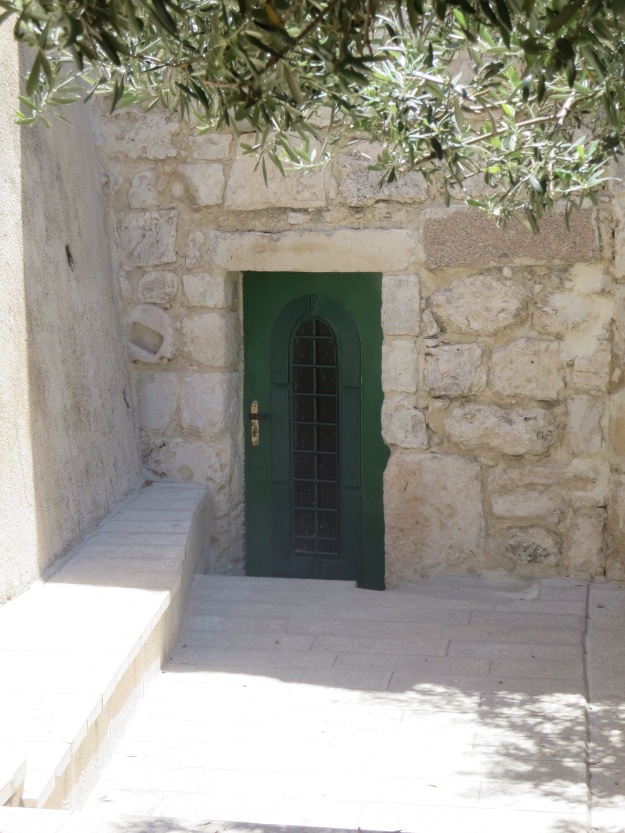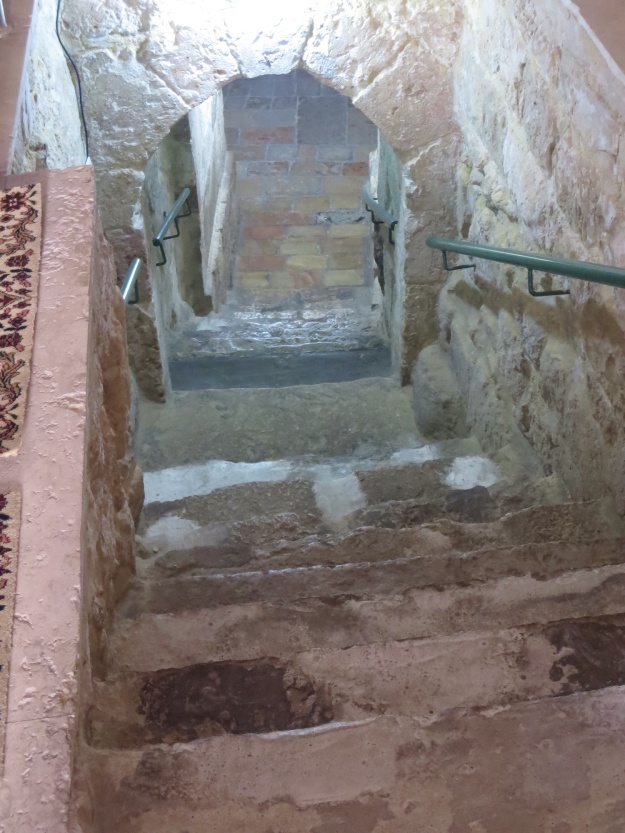Thursday 3rd July 2014
This morning I again made my way up the Mount of Olives to the (Muslim) Chapel of the Ascension. Nearby is a tomb said to be that of Rabia al-Adawiyya, a very famous Muslim mystic who promoted the idea of love for God.
Some years ago I had read somewhere that she was buried on the Mount of Olives and I was keen to find the grave. I had asked a young shopkeeper in the markets in Jerusalem about the location of her grave. The fact that he knew who and what I was asking about confirmed that she was indeed very well known in Muslim circles. He knew where she was buried and gave me general directions. Having arrived on the summit of the Mount of Olives, I kept asking people until I arrived at the site of the mausoleum. All this was a couple of days ago, but the gatekeeper who has the keys was not present. I was told he had gone down to the Temple Mount for prayers and would not be back until after 4.30. This was too late for me, I could not wait that long, with no guarantee that he would come then or even later, so I was not able to visit the tomb.
In the meantime, my ardour waned, as I had come across the following on the internet:
Burial crypt
The grounds also contain a burial crypt near the chapel that is revered by three separate monotheistic religions, although opinion differs on the occupant. Jews believe it contains the 7th-century BC prophetess Huldah, Christians believe it to be the tomb of the 5th-century saint Pelagia of Antioch; while Muslims maintain that the 8th-century Sufi mystic and Wali, Rabi’a al-Adawiya is buried there.
http://en.m.wikipedia.org/wiki/Chapel_of_the_Ascension_(Jerusalem)#Burial_crypt
However, ever since last year when I had planned to come to Jerusalem it had been my intention to find and visit this grave, so this morning I decided to fulfil that intention, regardless of who might have been interred there. I climbed up the Mount of Olives again, went to the grave-site, asked and found the gatekeeper who lived in a nearby house, asked about the keys, and was escorted by him through the gate and into the mausoleum.

Courtyard to the tomb of Rabia al-Adawiyya (?) near the Chapel of the Ascension on the Mount of Olives
Naturally, there are steps down into the actual tomb (much the same as to Lazarus’ tomb in Bethany – nothing is ever on level ground!), so I climbed down the steps.

Steps leading down to the tomb of Rabia al-Adawiyya (?) near the Chapel of the Ascension on the Mount of Olives
There was a domed area about three metres round with a flat floor and a sarcophagus on one side, covered with a green cloth with inscriptions embroidered in Arabic.
Why go to such bother when the occupant of the tomb is so dubious? My answer is the same as my introduction to her that I gave above. Rabia al-Adawiyya is a famous Muslim mystic. I have taught about her and quoted her mystical/spiritual poetry in my courses on Islam. She promoted the idea of love for God and popularised it among Muslims. She is well-known for her poetry, of which I have pasted a couple of examples:
If I adore You out of fear of Hell, burn me in Hell!
If I adore you out of desire for Paradise,
Lock me out of Paradise.But if I adore you for Yourself alone,
Do not deny to me Your eternal beauty.
Another of her famous poems is:
Love
I have loved Thee with two loves:
a selfish love and a love that is worthy of Thee.As for the love which is selfish,
Therein I occupy myself with Thee,
to the exclusion of all others.But in the love which is worthy of Thee,
Thou dost raise the veil that I may see Thee.Yet is the praise not mine in this or that,
But the praise is to Thee in both that and this.
Moreover, Rabia’ was a woman, in a field where men are usually prominent, another reason which makes her especially worthy of mention. She was also a celibate, most unusual among Muslims where marriage is almost mandatory, and her explanation of celibacy is as good as any I have ever read, that she is so totally consumed by God that He alone possesses her, and if she is to be given in marriage, then the suitor must ask God for her. Her analogy and profound explanation remind me of the verses in St Paul’s letter to the Galatians:
19 …. I have been crucified with Christ; 20 and it is no longer I who live, but it is Christ who lives in me. And the life I now live in the flesh I live by faith in the Son of God, who loved me and gave himself for me. (Galatians 2:19-20)
For all of the above reasons I was happy to visit that grave this morning, to remember Rabia’s love for God, regardless of who might be in the tomb.
For more information on Rabia al-Adawiyya check out some of the following websites:
http://www.rabianarker.com/html/rabia_stories.html
http://sufimaster.org/adawiyya.htm
http://www.thesufi.com/Sufi_biographies_and_stories/Rabia-Basri.htm
http://www.blissfulself.com/rabia.htm
and many others besides.
Shalom, Peace, Salaam!!!

Pingback: Seven Jerusalem Websites | Seth Ward--University of Wyoming--Courses
this is wondeful! I am in Jerusalem now and want to visit her ‘makam” (tomb). Can you please send some directions?
Blessings on your journey in Jerusalem. The tomb is near the top of the Mount of Olives. It is just across the intersection from the Pater Noster Church. Further up the road is the Chapel of the Ascension. Blessings on your pilgrimage.
Thank you Patrick, I am sorry for the late reply. But I was able to visit. And as you can see finally blogged about it. It’s quite strange (in a good way) that I just noticed this un-replied comment and it happens to be about Sh. Rabia.
Dear Farah, glad you were able to find the place. I have read your blog. It enabled me to revisit my memories of my ‘ziarat’ to her grave. Regards, Patrick
Thank you Patrick. Indeed, it is a special place.
Thank you so much for the pictures. I have also read her poetry and felt Rabia was closer to God than any academic or intellectual teacher of the holy laws of any religion. She loved God in a way that can inspire all of us.
Many thanks for sharing your journey so I can virtually take a pilgrimage to her holy site.
you are so lucky !!! wish i was there !